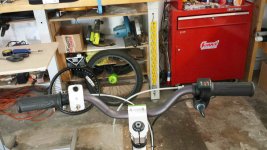Barncat said:
I think the pot throttle approach is what I'm looking for if I decide I can't live with the basic Hall twister.
Remember a pot throttle will need some extra resistors on the ground and the 5v line to give it's full mechanical range of control (so that it operates over the same voltage range as a hall throttle would, for those controllers with no way to adjust the input range).
A cable-operated hall throttle (COT) will, as Tommycat notes, be adjustable mechanically if necessary, changning the amount of cable pulled by the grip vs the amount of rotation of the COT for that cable pull, simply by changinng the input pulley size on the COT itself. To see basically how these look, you can go here:
https://endless-sphere.com/forums/viewtopic.php?f=2&t=105460
where I use a COT and a brake lever to get proportional regen (with a controller that has taht kind of input; most don't). I also use a separate COT on an ATV thumb throttle (cuz they're the only metal thumb throttles I can find...and the palstic ones break off when I hit bumps and am at WOT

).
They also make potentiometer versions of the COTs, but I haven't used those yet. These can actually be built relatively easily, vs building a hall COT. (at some point I'm probably going to convert a hall COT into a pot COT for a special purpose test).
However, I'm not clear on exactly what's happening at the instant the controller sees trigger voltage to kick the motor on (my controller spec says the range is 1.1- 3.7V btw...). Isn't an instantaneous hit going to by definition cause a jerky wheelie start as you refer to it TC in your #1 mod? Or is it the controllers job to spread that hit over some microseconds, which is where programming capability comes in?
What any controller *should* do is that as soon as the voltage on it's input reaches it's threshold, it should just barely begin applying power to the motor. As you increase throttle from there, it will continue to increase power to the motor. So there is no "hit", exactly.
How the controller responds from there is where you see the problem with sudden bursts of power with only a little throttle, or with one that gradually does so.
Some controllers also have a "soft start" which responds slowly to the initial (or any) change in throttle, and the rider may keep increasing throttle trying to get a response out of it and then when the controller does respond, it has already been told to output more (often much more) than minimal throttle...and with a higher torque setup, that can be disturbing.
Any controller that uses a "current throttle" or "torque throttle" method (generally FOC controllers do this) will be much more controllable than those using a simple "voltage throttle" or "PWM throttle" method. It doesn't have anything to do with the actual throttle itself, but just the method the controller uses of modulating power to the motor.
A hall throttle itself *also* can vary in how it outputs voltage from the point it begins to do so in it's motion range, up to the point it ceases to increase voltage output. Some of them are not linear, some are, and some are...different, wonky curves, due to the way they are mechanically built inside where the magnets are placed relative to the hall sensor, and how they are moved around by the throttle grip or thumb tab / lever / etc., and how the magnets are magnetized, and which hall sensor they used. And they vary a fair bit on how mcuh you have to move them before they begin outputting anything at all, and how far you can continue to move them without increasing voltage anymore once youv'e hit WOT.
A pot throttle still has the last issue, but there's really only two ways they "curve" the voltage output: linear, and logarithmic, depending on which type of pot they used. (and if you want one, but have the other, you can change the pot out).


